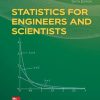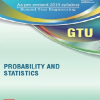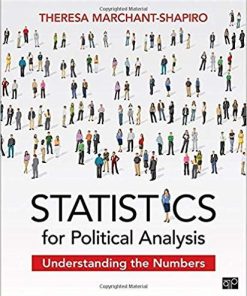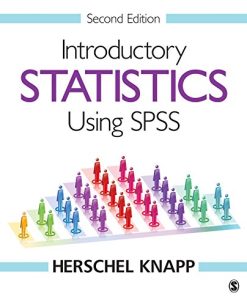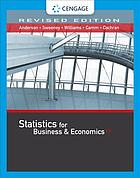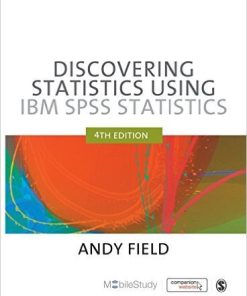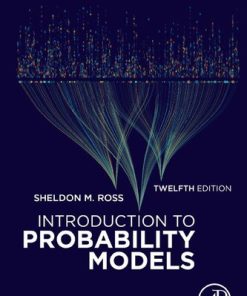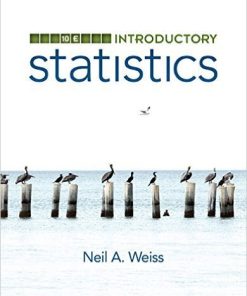(EBook PDF) Introductory statistics 4th Edition by Sheldon Ross 012804361X 9780128043615 full chapters
$50.00 Original price was: $50.00.$25.00Current price is: $25.00.
Introductory statistics 4th Edition by Sheldon M. Ross – Ebook PDF Instant Download/DeliveryISBN: 012804361X, 9780128043615
Full download Introductory statistics 4th Edition after payment.
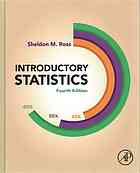
Product details:
ISBN-10 : 012804361X
ISBN-13 : 9780128043615
Author: Sheldon Ross
Introductory Statistics, Fourth Edition, reviews statistical concepts and techniques in a manner that will teach students not only how and when to utilize the statistical procedures developed, but also how to understand why these procedures should be used. The text’s main merits are the clarity of presentation, contemporary examples and applications from diverse areas, an explanation of intuition, and the ideas behind the statistical methods.
Concepts are motivated, illustrated, and explained in a way that attempts to increase one’s intuition. To quote from the preface, it is only when a student develops a feel or intuition for statistics that she or he is really on the path toward making sense of data. Ross achieves this goal through a coherent mix of mathematical analysis, intuitive discussions, and examples.
Introductory statistics 4th Table of contents:
Chapter 1: Introduction to Statistics
Abstract
1.1. Introduction
1.2. The Nature of Statistics
1.3. Populations and Samples
1.4. A Brief History of Statistics
Key Terms
The Changing Definition of Statistics
Review Problems
Chapter 2: Describing Data Sets
Abstract
2.1. Introduction
2.2. Frequency Tables and Graphs
Problems
2.3. Grouped Data and Histograms
Problems
2.4. Stem-and-Leaf Plots
Problems
2.5. Sets of Paired Data
Problems
2.6. Some Historical Comments
Key Terms
Summary
Review Problems
Chapter 3: Using Statistics to Summarize Data Sets
Abstract
3.1. Introduction
3.2. Sample Mean
Problems
3.3. Sample Median
Problems
Problems
3.4. Sample Mode
Problems
3.5. Sample Variance and Sample Standard Deviation
Problems
3.6. Normal Data Sets and the Empirical Rule
Problems
3.7. Sample Correlation Coefficient
Problems
3.8. The Lorenz Curve and Gini Index
Problems
3.9. Using R
Key Terms
Summary
Review Problems
Chapter 4: Probability
Abstract
4.1. Introduction
4.2. Sample Space and Events of an Experiment
Problems
4.3. Properties of Probability
Problems
4.4. Experiments Having Equally Likely Outcomes
Problems
4.5. Conditional Probability and Independence
Problems
*4.6. Bayes’ Theorem
Problems
*4.7. Counting Principles
Problems
Key Terms
Summary
Review Problems
Chapter 5: Discrete Random Variables
Abstract
5.1. Introduction
5.2. Random Variables
Problems
5.3. Expected Value
Problems
5.4. Variance of Random Variables
Problems
5.5. Jointly Distributed Random Variables
Problems
5.6. Binomial Random Variables
Problems
*5.7. Hypergeometric Random Variables
Problems
*5.8. Poisson Random Variables
Problems
5.9. Using R to calculate Binomial and Poisson Probabilities
Key Terms
Summary
Review Problems
Chapter 6: Normal Random Variables
Abstract
6.1. Introduction
6.2. Continuous Random Variables
Problems
6.3. Normal Random Variables
Problems
6.4. Probabilities Associated with a Standard Normal Random Variable
Problems
6.5. Finding Normal Probabilities: Conversion to the Standard Normal
6.6. Additive Property of Normal Random Variables
Problems
6.7. Percentiles of Normal Random Variables
Problems
6.8. Calculating Normal Probabilities with R
Key Terms
Summary
Review Problems
Chapter 7: Distributions of Sampling Statistics
Abstract
7.1. A Preview
7.2. Introduction
7.3. Sample Mean
Problems
7.4. Central Limit Theorem
Problems
7.5. Sampling Proportions from a Finite Population
Problems
7.6. Distribution of the Sample Variance of a Normal Population
Problems
Key Terms
Summary
Review Problems
Chapter 8: Estimation
Abstract
8.1. Introduction
8.2. Point Estimator of a Population Mean
Problems
8.3. Point Estimator of a Population Proportion
Problems
Problems
8.4. Estimating a Population Variance
Problems
8.5. Interval Estimators of the Mean ofa Normal Population with Known Population Variance
Problems
8.6. Interval Estimators of the Mean ofa Normal Population with Unknown Population Variance
Problems
8.7. Interval Estimators of a Population Proportion
Problems
8.8. Use of R
Key Terms
Summary
Review Problems
Chapter 9: Testing Statistical Hypotheses
Abstract
9.1. Introduction
9.2. Hypothesis Tests and Significance Levels
Problems
9.3. Tests Concerning the Mean of a Normal Population: Case of Known Variance
Problems
Problems
9.4. The t Test for the Mean of a Normal Population: Case of Unknown Variance
Problems
9.5. Hypothesis Tests Concerning Population Proportions
Problems
9.6. Use of R in Running a One Sample t-test
Key Terms
Summary
Review Problems and Proposed Case Studies
Chapter 10: Hypothesis Tests Concerning Two Populations
Abstract
10.1. Introduction
10.2. Testing Equality of Means of Two Normal Populations: Case of Known Variances
Problems
10.3. Testing Equality of Means: Unknown Variances and Large Sample Sizes
Problems
10.4. Testing Equality of Means: Small-Sample Tests when the Unknown Population Variances Are Equal
Problems
10.5. Paired-Sample t Test
Problems
10.6. Testing Equality of Population Proportions
Problems
10.7. Use of R in Running a Two Sample t-Test
Key Terms
Summary
Review Problems
Chapter 11: Analysis of Variance
Abstract
11.1. Introduction
11.2. One-Factor Analysis of Variance
Problems
11.3. Two-Factor Analysis of Variance: Introduction and Parameter Estimation
Problems
11.4. Two-Factor Analysis of Variance: Testing Hypotheses
Problems
11.5. Final Comments
Key Terms
Summary
Review Problems
Chapter 12: Linear Regression
Abstract
12.1. Introduction
12.2. Simple Linear Regression Model
Problems
12.3. Estimating the Regression Parameters
Problems
12.4. Error Random Variable
Problems
12.5. Testing the Hypothesis that β=0
Problems
12.6. Regression to the Mean
Problems
12.7. Prediction Intervals for Future Responses
Problems
12.8. Coefficient of Determination
Problems
12.9. Sample Correlation Coefficient
Problems
12.10. Analysis of Residuals: Assessingthe Model
Problems
12.11. Multiple Linear Regression Model
Problems
12.12. Logistic Regression
12.13. Use of R in Regression
Key Terms
Summary
Review Problems
Chapter 13: Chi-Squared Goodness-of-Fit Tests
Abstract
13.1. Introduction
13.2. Chi-Squared Goodness-of-Fit Tests
Problems
13.3. Testing for Independence in Populations Classified According to Two Characteristics
Problems
13.4. Testing for Independence in Contingency Tables with Fixed Marginal Totals
Problems
13.5. Use of R
Key Terms
Summary
Review Problems
Chapter 14: Nonparametric Hypotheses Tests
Abstract
14.1. Introduction
14.2. Sign Test
Problems
14.3. Signed-Rank Test
Problems
14.4. Rank-Sum Test for Comparing Two Populations
Problems
14.5. Runs Test for Randomness
Problems
14.6. Testing the Equality of Multiple Probability Distributions
Problems
14.7. Permutation Tests
Problems
Key Terms
Summary
Review Problems
Chapter 15: Quality Control
Abstract
15.1. Introduction
15.2. The X‾ Control Chart for Detecting a Shift in the Mean
Problems
Problems
15.3. Control Charts for Fraction Defective
Problems
15.4. Exponentially Weighted Moving-Average Control Charts
Problems
15.5. Cumulative-Sum Control Charts
Problems
Key Terms
Summary
Review Problems
Chapter 16: Machine Learning and Big Data
Abstract
16.1. Introduction
16.2. Late Flight Probabilities
16.3. The Naive Bayes Approach
Problems
16.4. Distance Based Estimators the k-Nearest Neighbors Rule
Problems
16.5. Assessing the Approaches
Problems
16.6. Choosing the Best Probability: A Bandit Problem
People also search for Introductory statistics 4th:
using r for introductory statistics
openstax introductory statistics answer key
best introductory statistics textbook
introductory statistics pdf
introductory statistics 10th edition
Tags:
Introductory,statistics,Sheldon Ross
You may also like…
Uncategorized
(eBook PDF) Statistics for Political Analysis: Understanding the Numbers Revised Edition
Uncategorized
eTextbook 978-9351500827 Discovering Statistics Using IBM SPSS Statistics, 4th Edition
Mathematics - Applied Mathematics
Mathematics - Probability
Introduction to Probability Models 12th Edition Sheldon M. Ross
Politics & Philosophy - Anthropology
Exploring Ethics An Introductory Anthology 5th Edition by Steven Cahn 0190887907 978-0190887902


